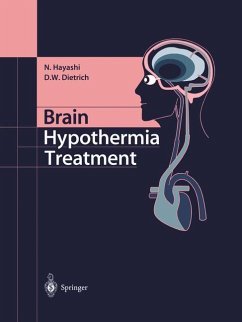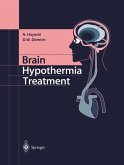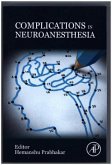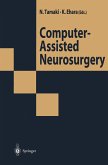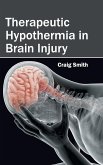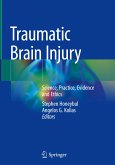- Gebundenes Buch
- Merkliste
- Auf die Merkliste
- Bewerten Bewerten
- Teilen
- Produkt teilen
- Produkterinnerung
- Produkterinnerung
Recent breakthroughs in understanding the effectiveness of brain hypothermia treatment have been brought about by rapid progress in experimental gene studies along with new findings in the areas of brain-injury mechanisms, brain thermo-pooling, hemoglobin dysfunction, insulin-resistant hyperglycemia, radical damage involving states of consciousness, management of lipid-dominant metabolism in the intensive care unit (ICU), and management of immune crises under conditions of hypothermia. This book explains the mechanism of brain hypothermia and presents advanced techniques for ICU management of…mehr
Andere Kunden interessierten sich auch für
![Brain Hypothermia Treatment Brain Hypothermia Treatment]() Nariyuki HayashiBrain Hypothermia Treatment115,99 €
Nariyuki HayashiBrain Hypothermia Treatment115,99 €![Hypothermia for Acute Brain Damage Hypothermia for Acute Brain Damage]() Nariyuki Hayashi / Ross Bullock / Dalton W. Dietrich / Tsuyoshi Maekawa / Akira Tamura (eds.)Hypothermia for Acute Brain Damage153,99 €
Nariyuki Hayashi / Ross Bullock / Dalton W. Dietrich / Tsuyoshi Maekawa / Akira Tamura (eds.)Hypothermia for Acute Brain Damage153,99 €![Hypothermia for Acute Brain Damage Hypothermia for Acute Brain Damage]() Hypothermia for Acute Brain Damage168,99 €
Hypothermia for Acute Brain Damage168,99 €![Complications in Neuroanesthesia Complications in Neuroanesthesia]() Complications in Neuroanesthesia79,99 €
Complications in Neuroanesthesia79,99 €![Computer-Assisted Neurosurgery Computer-Assisted Neurosurgery]() Computer-Assisted Neurosurgery38,99 €
Computer-Assisted Neurosurgery38,99 €![Therapeutic Hypothermia in Brain Injury Therapeutic Hypothermia in Brain Injury]() Therapeutic Hypothermia in Brain Injury87,99 €
Therapeutic Hypothermia in Brain Injury87,99 €![Traumatic Brain Injury Traumatic Brain Injury]() Traumatic Brain Injury112,99 €
Traumatic Brain Injury112,99 €-
-
-
Recent breakthroughs in understanding the effectiveness of brain hypothermia treatment have been brought about by rapid progress in experimental gene studies along with new findings in the areas of brain-injury mechanisms, brain thermo-pooling, hemoglobin dysfunction, insulin-resistant hyperglycemia, radical damage involving states of consciousness, management of lipid-dominant metabolism in the intensive care unit (ICU), and management of immune crises under conditions of hypothermia. This book explains the mechanism of brain hypothermia and presents advanced techniques for ICU management of brain hypothermia for critically brain-injured patients. Especially useful for bedside care in the ICU are the easy-reference care-management "cards" in the appendix of the book. Brain Hypothermia Treatment provides a valuable resource and practical guide for professionals in the fields of neurosurgery and emergency and critical care medicine.
Hinweis: Dieser Artikel kann nur an eine deutsche Lieferadresse ausgeliefert werden.
Hinweis: Dieser Artikel kann nur an eine deutsche Lieferadresse ausgeliefert werden.
Produktdetails
- Produktdetails
- Verlag: Springer / Springer Japan / Springer, Berlin
- Artikelnr. des Verlages: 10939833, 978-4-431-40446-0
- 2004
- Seitenzahl: 344
- Erscheinungstermin: 29. September 2003
- Englisch
- Abmessung: 286mm x 215mm x 24mm
- Gewicht: 1092g
- ISBN-13: 9784431404460
- ISBN-10: 4431404465
- Artikelnr.: 21853405
- Herstellerkennzeichnung
- Springer-Verlag GmbH
- Tiergartenstr. 17
- 69121 Heidelberg
- ProductSafety@springernature.com
- Verlag: Springer / Springer Japan / Springer, Berlin
- Artikelnr. des Verlages: 10939833, 978-4-431-40446-0
- 2004
- Seitenzahl: 344
- Erscheinungstermin: 29. September 2003
- Englisch
- Abmessung: 286mm x 215mm x 24mm
- Gewicht: 1092g
- ISBN-13: 9784431404460
- ISBN-10: 4431404465
- Artikelnr.: 21853405
- Herstellerkennzeichnung
- Springer-Verlag GmbH
- Tiergartenstr. 17
- 69121 Heidelberg
- ProductSafety@springernature.com
Nariyuki Hayashi, Nihon University School of Medicine, Tokyo, Japan / Dalton W. Dietrich, The Miami Project Neurotrauma Research Center, Miami, FL, USA
Basic Research.- I. Basic Science of Brain Hypothermia.- 1. Global and Focal Cerebral Ischemia.- 2. Limitations of Postischemic Hypothermia.- 3. The Importance of Chronic Outcome Measures in Assessing Neuroprotective Strategies.- 4. Traumatic Brain Injury.- 5. Traumatic Axonal Injury.- 6. Behavioral Improvements with Posttraumatic Hypothermia.- 7. Brain Tissue Temperature Measurements in Clinical Setting.- 8. Traumatic and Ischemic Hyperthermia.- 9. Rewarming Phase.- 10. Therapeutic Hypothermia in Complicated Models of Traumatic Brain Injury.- 11. Mechanisms of Hypothermic Protection.- 12. Excitotoxicity.- 13. Free Radical Production.- 14. Decrease of Vascular Permeability.- 15. Nitric Oxide.- 16. Cerebral Blood Flow.- 17. Inflammation.- 18. Gene Expression and Apoptosis.- 19. Summary and Future Directions.- Clinical Management.- II. Overview of Clinical Development of Brain Hypothermia Treatment.- 20. Mechanism of Brain Damage and Management of Severe Brain Injury Based on Laboratory Studies.- 21. History of Clinical Trials of Hypothermia Treatment of Severe Brain Injury.- 22. Secondary Brain Injury Mechanism of HypothalamusPituitary- Adrenal Axis Neurohormonal Activation in Severely Brain-Injured Patients.- 23. Clinical Failures of Previous Hypothermia Management.- 24. The Difference in Brain Injury Mechanism in Experimental Laboratory Models and Human Patients.- 25. The Regulatory Mechanism of Brain Tissue Temperature and Brain Thermo-pooling.- 26. The Target of Treatment of Severe Brain Injury in the Acute Stage.- 27. New Concept of Brain Hypothermia Treatment.- III. Approach to Brain Hypothermia Treatment.- 28. Contraindications.- 29. Indications.- 30. Beyond Indication and Contraindication.- IV. The Technique of Brain Hypothermia Treatment.- 31. Induction of BrainHypothermia.- 32. The Protocol for Brain Hypothermia Treatment.- 33. Mistakes and Pitfalls of Brain Hypothermia Treatment.- 34. Concepts in Brain Tissue Temperature Control.- 35. Management of Brain Tissue Temperature.- 36. Intensive Care Unit Bed Design for Brain Hypothermia.- 37. Design of the Intensive Care Unit for Brain Hypothermia Treatment.- 38. Preparation for Management of Brain Hypothermia.- 39. Noninvasive Monitoring of Brain Damage.- 40. Neuron Protection in Injured Brain Tissue During Surgery.- 41. Prolonged Anesthesia for Brain Hypothermia Treatment in ICU.- 42. Imaging and Monitoring for Brain Hypothermia Management.- 43. Induction of Brain Hypothermia Treatment.- 44. Management During the Cooling Stage.- 45. Timing of Rewarming.- 46. Preconditioning for Rewarming.- 47. Management of Rewarming.- V. Prevention of Memory Disturbances and Vegetative State.- 48. Clinical Issues in the Management of Unconsciousness and Vegetative State Patients.- 49. The New Concept of Unconsciousness and Mechanism of Vegetation.- 50. Diagnosis of Reversibility of the Vegetative State.- 51. Management of Complicated Neuronal Dysfunction: Emotion, Memory, Cognition, and Behavior.- 52. Surgical Management After Brain Hypothermia Treatment to Prevent Vegetation and Memory Disturbance.- 53. Indications and Criteria for Dopamine Replacement Therapy.- VI. Specific Consideration for Disease: Cardiac Arrest, Occlusive Cerebral Stroke, and Subarachnoid Hemorrhage.- 54. Brain Hypothermia After Resuscitation from Cardiopulmonary Arrest.- 55. Brain Hypothermia for Occlusive Cerebral Stroke.- 56. Special Consideration of Brain Hypothermia Treatment for Subarachnoid Hemorrhage.- VII. Clinical Outcome of Brain Hypothermia Treatment.- 57. Severe Brain Trauma.- 58. Cardiac Arrest.- VIII. Clinical Protocol for Application of Brain Hypothermia.- 59. Critical Path of Brain Hypothermia Treatment.- 60. Closing Remarks.- Appendix. Critical Pathway of Brain Hypothermia Treatment.
Basic Research.- I. Basic Science of Brain Hypothermia.- 1. Global and Focal Cerebral Ischemia.- 2. Limitations of Postischemic Hypothermia.- 3. The Importance of Chronic Outcome Measures in Assessing Neuroprotective Strategies.- 4. Traumatic Brain Injury.- 5. Traumatic Axonal Injury.- 6. Behavioral Improvements with Posttraumatic Hypothermia.- 7. Brain Tissue Temperature Measurements in Clinical Setting.- 8. Traumatic and Ischemic Hyperthermia.- 9. Rewarming Phase.- 10. Therapeutic Hypothermia in Complicated Models of Traumatic Brain Injury.- 11. Mechanisms of Hypothermic Protection.- 12. Excitotoxicity.- 13. Free Radical Production.- 14. Decrease of Vascular Permeability.- 15. Nitric Oxide.- 16. Cerebral Blood Flow.- 17. Inflammation.- 18. Gene Expression and Apoptosis.- 19. Summary and Future Directions.- Clinical Management.- II. Overview of Clinical Development of Brain Hypothermia Treatment.- 20. Mechanism of Brain Damage and Management of Severe Brain Injury Based on Laboratory Studies.- 21. History of Clinical Trials of Hypothermia Treatment of Severe Brain Injury.- 22. Secondary Brain Injury Mechanism of HypothalamusPituitary- Adrenal Axis Neurohormonal Activation in Severely Brain-Injured Patients.- 23. Clinical Failures of Previous Hypothermia Management.- 24. The Difference in Brain Injury Mechanism in Experimental Laboratory Models and Human Patients.- 25. The Regulatory Mechanism of Brain Tissue Temperature and Brain Thermo-pooling.- 26. The Target of Treatment of Severe Brain Injury in the Acute Stage.- 27. New Concept of Brain Hypothermia Treatment.- III. Approach to Brain Hypothermia Treatment.- 28. Contraindications.- 29. Indications.- 30. Beyond Indication and Contraindication.- IV. The Technique of Brain Hypothermia Treatment.- 31. Induction of BrainHypothermia.- 32. The Protocol for Brain Hypothermia Treatment.- 33. Mistakes and Pitfalls of Brain Hypothermia Treatment.- 34. Concepts in Brain Tissue Temperature Control.- 35. Management of Brain Tissue Temperature.- 36. Intensive Care Unit Bed Design for Brain Hypothermia.- 37. Design of the Intensive Care Unit for Brain Hypothermia Treatment.- 38. Preparation for Management of Brain Hypothermia.- 39. Noninvasive Monitoring of Brain Damage.- 40. Neuron Protection in Injured Brain Tissue During Surgery.- 41. Prolonged Anesthesia for Brain Hypothermia Treatment in ICU.- 42. Imaging and Monitoring for Brain Hypothermia Management.- 43. Induction of Brain Hypothermia Treatment.- 44. Management During the Cooling Stage.- 45. Timing of Rewarming.- 46. Preconditioning for Rewarming.- 47. Management of Rewarming.- V. Prevention of Memory Disturbances and Vegetative State.- 48. Clinical Issues in the Management of Unconsciousness and Vegetative State Patients.- 49. The New Concept of Unconsciousness and Mechanism of Vegetation.- 50. Diagnosis of Reversibility of the Vegetative State.- 51. Management of Complicated Neuronal Dysfunction: Emotion, Memory, Cognition, and Behavior.- 52. Surgical Management After Brain Hypothermia Treatment to Prevent Vegetation and Memory Disturbance.- 53. Indications and Criteria for Dopamine Replacement Therapy.- VI. Specific Consideration for Disease: Cardiac Arrest, Occlusive Cerebral Stroke, and Subarachnoid Hemorrhage.- 54. Brain Hypothermia After Resuscitation from Cardiopulmonary Arrest.- 55. Brain Hypothermia for Occlusive Cerebral Stroke.- 56. Special Consideration of Brain Hypothermia Treatment for Subarachnoid Hemorrhage.- VII. Clinical Outcome of Brain Hypothermia Treatment.- 57. Severe Brain Trauma.- 58. Cardiac Arrest.- VIII. Clinical Protocol for Application of Brain Hypothermia.- 59. Critical Path of Brain Hypothermia Treatment.- 60. Closing Remarks.- Appendix. Critical Pathway of Brain Hypothermia Treatment.

